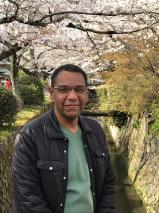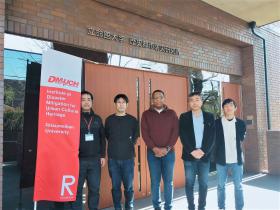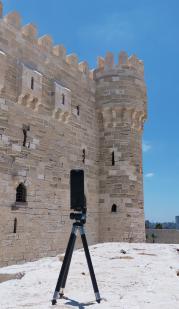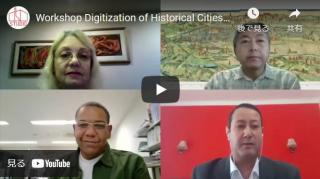-
ARC-iJAC Project Spotlights: An Interview with Dr. Mohamed Soliman on 'Qait'bay Citadel (1477-1479): Visualizing the Main Coastal Fortification of Medieval Alexandria, Egypt'April 11, 2022(Mon)
Background:
Dr. Mohamed Soliman is an Egyptian archaeologist and the Director of the Advanced Studies Unit for Cultural Heritage at the National Research Institute of Astronomy and Geophysics (NRIAG) in Cairo. While completing his two-year JSPS Postdoctoral Research Fellowship at Ritsumeikan University's Institute of Disaster Mitigation for Urban Cultural Heritage (DMUCH), Dr. Soliman started his research project "Qait'bay Citadel (1477-1479): Visualizing the Main Coastal Fortification of Medieval Alexandria, Egypt" in FY 2021 supported by the ARC-iJAC. Dr. Soliman, thank you very much for this interview. How was your time here in Japan?
Dr. Soliman, thank you very much for this interview. How was your time here in Japan?Dr. Soliman: Thank you. Although the pandemic hit us soon after my arrival, and I had to adapt my research plans, I had a rewarding time in Japan. The field of cultural heritage studies, in particular, relies a lot on field data acquisition, so working from home is difficult.
However, I received a lot of guidance from my host professor Keiji Yano* to achieve my research goals, conduct joint research and expand my network within the Japanese research community.
*Professor Keiji Yano (College of Letters, Ritsumeikan University) is a Deputy Director of the Art Research Center.
Could you please tell us why you started the project of visualizing Qait'bay Fort?

Dr. Soliman: Qait'bay Fort, built in the 15th century, is not only considered one of the most significant fortifications in Egypt but along the Mediterranean Sea.
The Fort stands on the same site as the legendary Pharos Lighthouse. However, it is exposed to natural and man-made disasters such as seismic hazards and tsunamis due to this location.
The fire disaster at Notre Dame Cathedral in Paris in 2019 reminded us of the importance of 3D visualization to preserve and document cultural heritages at risk and make our research outcomes available to scholars and the public alike.
At the same time, the project contributes to the sustainability goals of our local tourism industry, reflected in the Sustainable Development Strategy (SDS): Egypt Vision 2030.
Furthermore, we consider this a prototype project to build bridges of scientific collaboration between Ritsumeikan University, E-JUST** and NRIAG.
**Egypt-Japan University of Science and Technology (E-JUST)
How do you feel about the execution of this project until now?
 Dr. Soliman: Despite the exceptional circumstances caused by the pandemic, I was able to make a field trip to Egypt, enabling us to collect rich data. A part of the historical data was collected in collaboration with two archaeologists from the Ministry of Tourism and Antiquities (MoTA), who will continue to participate in the fieldwork.
Dr. Soliman: Despite the exceptional circumstances caused by the pandemic, I was able to make a field trip to Egypt, enabling us to collect rich data. A part of the historical data was collected in collaboration with two archaeologists from the Ministry of Tourism and Antiquities (MoTA), who will continue to participate in the fieldwork.Since this project is just a start to creating a virtual tour of Qait'bay Fort, we carried out basic tasks such as determining the advantages of the tools used for data collection and the appropriate software for data processing.
We also held a one-day online workshop 'Digitization of Historical Cities in Egypt and Japan' in November 2021 that showcased the diverse contributions of Japanese and Egyptian institutions in Digital Humanities.
Have you come across particular challenges during the execution of this project?
Dr. Soliman: The fact that Quait'bay Citadel is a tourist site open to visitors and its weather conditions in winter posed a challenge to accurate data collection. We had to arrange the time of fieldwork and duration accordingly.
Furthermore, the rich data we obtained requires more advanced software for data processing than the one I am using. I will tackle this issue in the next phase of the project.
Speaking of the next phase, could you tell us more about your plans for FY 2022?
Dr. Soliman: In line with our main objectives, we will continue to carry out the integrated visualization of Qait'bay Fort to create a panoramic tour based on 3D imaging and consider how it can serve research, education, and tourism promotion purposes. We plan to launch an interactive website dedicated to publicizing the dataset and raising awareness of the importance of visualizing cultural heritages at risk.
In the future, I would like to apply more advanced tools, including drones and terrestrial laser scanners.
Finally, I hope to collaborate with ARC members of the Graduate School of Information Science and Engineering, Ritsumeikan, to learn from their experience in the 3D visualization of large-scale cultural heritages in Japan and Indonesia to advance and promote our research agenda further.
We also look forward to continuing working with you. Your project provides a valuable opportunity to strengthen the ties between the ARC, Ritsumeikan University, and our Egyptian partner institutions.
Dr. Soliman: Yes. Under the supervision of Prof. Yano and with the kind support of Ritsumeikan University's President Nakatani***, I am working on facilitating scientific collaboration with the Egypt-Japan University of Science and Technology (E-JUST).
Professor Mona G. Ibrahim, Dean of the School of Energy Resources, Environmental, and Chemical and Petrochemical Engineering (EECE), has already been involved in this project as Co-Principal Investigator.
Subsequently, I would like to enlarge our network to include NRIAG and the MoTA to strengthen our scientific research relationship, facilitate knowledge exchange, and foster young researchers of the joint partners.
***Professor Yoshio Nakatani, President of Ritsumeikan University, was appointed a member of the E-JUST Board of Trustees in July 2019 and has been deeply involved in the university management.
Dr. Soliman, thank you very much for your time. We are very much looking forward to the further development of your project.
(This interview was conducted by Yinzi Emily Li.)














